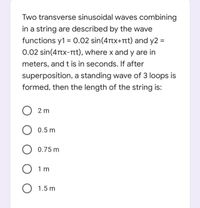Question

Transcribed Image Text:Two transverse sinusoidal waves combining
in a string are described by the wave
functions y1 = 0.02 sin(4Ttx+Tt) and y2 =
0.02 sin(4Ttx-Ttt), where x and y are in
meters, and t is in seconds. If after
superposition, a standing wave of 3 loops is
formed, then the length of the string is:
O 2m
0.5 m
O 0.75 m
O 1m
O 1.5 m
Expert Solution
This question has been solved!
Explore an expertly crafted, step-by-step solution for a thorough understanding of key concepts.
Step by stepSolved in 2 steps

Knowledge Booster
Similar questions
- A standing wave on a string of length L- 3 m is described by the following equation: y(x,t) = 0.08 sin(2TIX) cos(300rt). The fundamental frequency, fi, is: 50 Hz 300 Hz O 150 Hz 25 Hz O75 Hz string with a tension force FT and of length L 2arrow_forwardTwo transverse sinusoidal waves combining in a string are described by the wave functions y1 = 0.02 sin(2Ttx+Ttt) and y2 = %3D 0.02 sin(2rtx-Tt), where x and y are in meters, and t is in seconds. If after superposition, a standing wave of 3 loops is formed, then the length of the string is: 0.5 m 1 m 2 m 0.75 m 1.5 marrow_forwardA standing wave has the following wave-function: y(x,t) = 0.2 sin(TIX) cos(12Ttt), where x and y are in meters, and t is in seconds. If the length of the string is L = 2 m and it is fixed at both ends, then the harmonic, n, in which the string is vibrating is: O n= 3 O n= 6 O n = 5 n = 2 n = 4 A standing wave with wavelength A = 1.2 m and frequency f = 50 Hz is generated on a stretched cord. For an element of the cord at x = 0.5 m, the maximum transverse velocity is v(y,max) = 2t m/s. The amplitude A of each of the individual waves producina the standing wave is:arrow_forward